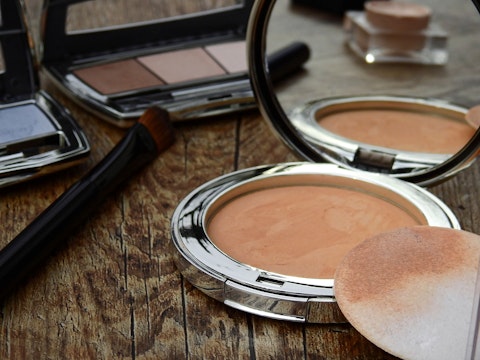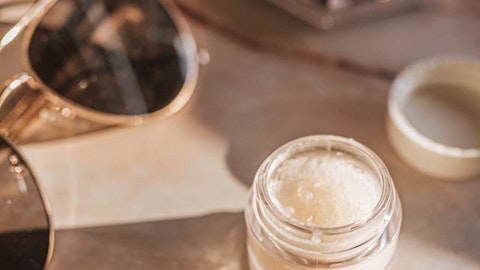Yatsen Holding Limited (NYSE:YSG) Q4 2022 Earnings Call Transcript March 9, 2023
Operator: Ladies and gentlemen, good day, and welcome to the Yatsen Fourth Quarter and Full Year 2022 Earnings Conference Call. At this time, I would like to turn the conference over to Irene Lyu, Vice President, Head of Strategic Investments and Capital Markets. Please go ahead.
Irene Lyu: Thank you, operator. Please note the discussion today will contain forward-looking statements relating to the company’s future performance and are intended to qualify for the Safe Harbor from liability as established by the U.S. Private Securities Litigation Reform Act. Such statements are not guarantees of future performance and are subject to certain risks and uncertainties, assumptions and other factors. Some of these risks are beyond the company’s control and could cause actual results to differ materially from those mentioned in today’s press release and this discussion. A general discussion of the risk factors that could affect Yatsen’s business and financial results is included in certain filings of the company with the Securities and Exchange Commission.
The company does not undertake any obligation to update this forward-looking information, except as required by law. During today’s call, management will also discuss certain non-GAAP financial measures for comparison purposes only. Please see the earnings release issued earlier today for a definition of non-GAAP financial measures and a reconciliation of GAAP to non-GAAP financial results. Joining us today on the call from Yatsen’s senior management are Mr. Jinfeng Huang, our Founder, Chairman, and CEO; and Mr. Donghao Yang, our CFO and Director. Management will begin with prepared remarks, and the call will conclude with a QA session. As a reminder, this conference is being recorded. In addition, a webcast replay of this conference call will be available on Yatsen’s Investor Relations website at ir.yatsenglobal.com.
I will now turn the call over to Mr. Jinfeng Huang. Please go ahead, sir.
Jinfeng Huang: Thank you, Irene, and thank you, everyone for participating in Yatsen’s fourth quarter and full year 2022 earnings conference call today. 2022 was a year of transformation for Yatsen. Early in the year, we launched our new 5-year strategy plan with an eye towards long-term sustainable growth and began refining our product category mix channel mix and the business model accordingly. This road map guided our steps amid the myriad of challenges in 2023, including the recurrent COVID-19 outbreak and the related lockdowns. China’s beauty industry continues to struggle with this macro headwind, and the consumer sentiment remained weak overall. Nevertheless, our Skincare Brands remained a bright spot for 2022 recording solid growth in sales.
We also achieved significant profitability improvements both increasing gross margin and narrowing net loss margin, and turned profitable under non-GAAP measures for the fourth quarter of 2022. According to the adjusted data published by the China National Bureau of Statistics, China’s total beauty retail sales in the fourth quarter of 2022 recorded a negative growth of 3.1% year-over-year, while for the full year 2022 China’s beauty retail sales declined by 3.2% year-over-year. On Tmall, color cosmetic sales fell by double-digits and the sales of skincare products experienced a single-digit decline year-over-year in 2023. However, we have seen a light at the end of the tunnel with the resumption of offline activities and the adjustment of COVID restrictions.
The consumer market is well on its way to a recovery in 2023. Against this backdrop, our overall sales slowed down throughout the year. Total net revenues declined by 34.2% year-over-year in the fourth quarter to RMB1.01 billion. But we need to look at our revenue mix in detail to see the full picture. Net revenues for our Skincare Brands increased by 42.4% year-over-year to RMB471.6 million, highlighted by outstanding performance among our fast-growing clinical and premium brands, including DR. WU, Galenic and Eve Lom, which recorded a robust growth of 73% year-over-year and the 99.3% year-over-year in combined net revenues for the fourth quarter and full year of 2022 respectively. In terms of revenue contribution, our Skincare Brands accounted for 46.9% of total net revenues in the fourth quarter and 33.5% for the full year of 2022, more than doubling compared with the prior year period in both cases.
Our Color Cosmetics Brands, on the other hand, saw a decline of 56.9% year-over-year in sales to RMB513.4 million, reflecting the continued softness in the market demand for color cosmetic products as well as intensified industry competition from both domestic and international brands. As we move into 2023, we will continue to build on our skincare portfolio success while addressing the challenges in the color cosmetics brands. Turning now to profitability, thanks to higher contribution from our Skincare Brands, more disciplined pricing and discount policies and continued cost optimization across all our brands, our gross margin increased by 6.1 percentage points to 71.1% for the fourth quarter from 55% a year ago. Net loss margin for the fourth quarter narrowed to 5.5% from 31.1% for the prior year period.
Most importantly, we recorded a non-GAAP net income margin for 3.4% for the fourth quarter as compared with a non-GAAP net loss margin of 14.7% for the third quarter and the non-GAAP net loss margin of 21.9% for the prior year period. We have been striving to achieve non-GAAP profitability by elevating operational efficiencies and closing underperforming offline stores among other cost optimization measures. Next, let me share some of our operational highlights from the fourth quarter and the full year 2022. Throughout the year, we created and delivered products tailored to Chinese consumers purposes. Galenic enjoyed broad success including with two featured products at the China International Import Expo as its antioxidant number one VC serum and its newly upgraded platinum LANEIGE serum.
The latter also ranked among the top 5 imported serum on Tmall during the Double 11 Shopping Festival. At the same time, in DR. WU’s Mandelic’s Daily Renewal Serum took the number one position in both Tmall’s vacuum treatment and Douyin’s domestic serum categories. While its long iconic cleansing serum, cleanse inclusion ranked first among high-end cleanser products on Tmall. For our Color Cosmetics Brands, we focused on cost optimization given the overall softening in the color cosmetic market as well as our own strategy goals for the fourth quarter. And going forward, with a more sustainable business model in mind, we will continue to develop our color cosmetic product portfolio to capitalize on anticipated consumption will rebound in 2023.
In addition to product development, branding is another key pillar of our strategy transformation. We strive continually to enhance the brand image and the positioning of our various brands among our diverse consumer cohort. For example, Eve Lom hosted its eternal gold cleanser global luxury class, imported it globally, while also sharing offline thermal wax therapy serums with Chinese audience at its SpaChina Wellness Summit in October 2022. Furthermore, Perfect Diary’s ReadMe Liquid Lipstick was awarded the 2022 national consumption word of mouth product by People’s Daily, a powerful commendation of its brand influence. In terms of channel optimization, we selectively closed offline stores and aggressively promoted our Douyin presence to diversify our online channels.
As of December 31, 2022, we operated 158 offline serum stores for the Perfect Diary brand as compared with from 286 stores at the end of 2021. This strategy shift has enabled us to cut costs whilst enjoying brand exposure across the country. Among our major online channels, Douyin stood out with its relatively high growth. Sales of our products on Douyin grew rapidly throughout 2022. Next, I would like to share some highlights of the progress we have made with our continued investments in R&D, which provide vital support to new product launches and long-term development of our brands. For the full year 2022, our R&D expenses increased to 3.4% of total net revenues from 2.4% for the prior year period. In November, we officially signed a joint laboratory cooperation agreement with Sun Yat-Sen University for skin health research, an exciting partnership that will enable us to further explore opportunities in both color cosmetics and skincare.
We are also thrilled to announce the appointment of our new Chief Scientific Officer, Ms. Jing Cheng. She has over 25 years experience in research and development in the beauty industry. Prior to joining Yatsen, Ms. Cheng worked at the Estee Lauder for 17 years serving in a number of senior management and research position, including as Vice President of APAC R&D, since July 2014. And from July 2001 to January 2005, she worked at Revlon, leading technical, quality control, regulatory and manufacturing organizations. With our CFO on board, we will remain focused on strengthening our R&D capabilities as our core strategy for future growth and product differentiation. Before I wrap up, I would like to mention our environmental, social and governance performance in 2022.
In the latest ESG rating published in December 2022 by the world’s leading largest index company, MSCI, we were upgraded to Level A, leading China’s cosmetic brands. This upgrade clearly reflects our endeavor to improve our products eco design and carbon footprint, our employee wellness initiative and our corporate governance, among other ESG enhancements. We also devoted more resources to multiple social welfare programs at both the company and brand level. Galenic, for instance, launched a new pink October limited edition of its Aqua Infini Skincare Lotion in support of breast cancer research. As always, we remain deeply committed to upholding our corporate social responsibility and we will continue to seek new ways to support people and communities in need.
While we expect the retail environment to remain challenging for the first half of 2023, we remain confident about the progress of China’s beauty industry. We made significant progress in our strategy transformation in 2022 and also reserved sufficient resources to achieve our strategy objectives in 2023. With growing contributions for our Skincare Brand, improved gross margin and streamlined operations, we are well positioned to execute these facilities and capitalize on rising opportunity as the consumer market recovers. With that, I will now turn the call over to our CFO, Donghao Yang, to discuss our financial performance. Thank you everyone.

Pixabay/Public Domain
Donghao Yang: Thank you, David, and hello, everyone. Before I get started, I would like to clarify that all financial numbers presented today are in renminbi amounts and all percentage changes refer to year-over-year changes unless otherwise noted. Total net revenues for the fourth quarter of 2022 decreased by 34.2% to RMB1.01 billion from RMB1.53 billion for the prior year period. The decrease was primarily attributable to a 56.9% year-over-year decrease in net revenues from Color Cosmetics Brands, partially offset by a 42.4% year-over-year increase in net revenues from Skincare Brands. Gross profit for the fourth quarter of 2022 decreased by 28% to RMB714.6 million from RMB993 million for the prior year period. Gross margin for the fourth quarter of 2022 increased to 71.1% from 65% for the prior year period.
The increase was driven by increasing sales of higher gross margin products from our Skincare Brands. And second, stricter pricing and discount policies. And third, cost optimization across all of our brand portfolios. Total operating expenses for the fourth quarter of 2022 decreased by 47% to RMB792.9 million from RMB1.49 billion for the prior year period. As a percentage of total net revenues, total operating expenses for the fourth quarter of 2022 were 78.9% as compared with 97.8% for the prior year period. Fulfillment expenses for the fourth quarter of 2022 were RMB62.5 million as compared with RMB123.1 million for the prior year period. As a percentage of total net revenue, fulfillment expenses for the fourth quarter of 2022 decreased to 6.2% from 8.1% for the prior year period.
The decrease was primarily attributable to a decrease in warehouse and logistics cost due to the outsourcing of most of our warehouse and handling operations. Selling and marketing expenses for the fourth quarter of 2022 were RMB535.2 million as compared with RMB1.08 billion for the prior year period. As a percentage of total net revenues, selling and marketing expenses for the fourth quarter of 2022 decreased to 53.2% from 70.7% for the prior year period. The decrease was primarily attributable to the closure of underperforming offline stores, reduction in marketing event-related expenses and higher efficiency of online marketing activities. General and administrative expenses for the fourth quarter of 2022 were RMB170 million as compared with RMB248.7 million for the prior year period.
As a percentage of total net revenues, general and administrative expenses for the fourth quarter of 2022 increased to 16.9% from 16.3% for the prior year period. The increase was primarily attributable to the deleveraging effect of lower total net revenues in the fourth quarter of 2022. Research and development expenses for the fourth quarter of 2022 were RMB25.1 million as compared with RMB43.3 million for the prior year period. As a percentage of total net revenues, research and development expenses for the fourth quarter of 2022 decreased to 2.5% from 2.8% for the prior year period. The decrease was primarily attributable to the planning of research and development activities to maintain research and development expenses at a reasonable level relative to net revenues.
Loss from operations for the fourth quarter of 2022 decreased by 84.4% to RMB78.2 million from RMB501.8 million for the prior year period. Operating loss margin was 7.8%, as compared with 32.8% for the prior year period. Non-GAAP income from operations for the fourth quarter of 2022 was RMB11.5 million as compared with non-GAAP loss from operations of RMB360.9 million for the prior year period. Non-GAAP operating income margin was 1.1%, as compared with non-GAAP operating loss margin of 23.6% for the prior year period. Net loss for the fourth quarter of 2022 decreased by 88.4% to RMB55 million from RMB475.1 million for the prior year period. Net loss margin was 5.5%, as compared with 31.1% for the prior year period. Net loss attributable to Yatsen’s ordinary shareholders per diluted ADS for the fourth quarter of 2022 was RMB0.09 as compared with RMB0.75 for the prior year period.
Non-GAAP net income for the fourth quarter of 2022 was RMB34.7 million as compared with non-GAAP net loss of RMB335.1 million for the prior year period. Non-GAAP net income margin was 3.4%, as compared with non-GAAP net loss margin of 21.9% for the prior year period. Non-GAAP net income attributable to Yatsen’s ordinary shareholders per diluted ADS for the fourth quarter of 2022 was RMB0.06 as compared with non-GAAP net loss attributable to Yatsen’s ordinary shareholders per diluted ADS of RMB0.53 for the prior year period. Now, I’d like to briefly walk through the highlights of our full year results. Total net revenues for the full year of 2022 decreased by 36.5% to RMB3.71 billion from RMB5.84 billion for the prior year period, primarily attributable to the decline in net revenues from Color Cosmetics Brands, partially offset by the increase in net revenues from Skincare Brands.
Gross profit for the full year of 2022 decreased by 35.4% to RMB2.52 billion from RMB3.9 billion for the prior year period. Gross margin for the full year of 2022 was 68%, as compared with 66.8% for the prior year period. The increase was primarily attributable to: first, increasing sales of higher gross margin products from Skincare Brands; and second, stricter pricing and discount policies; and third, cost optimization across all of the company’s brand portfolios. Loss from operations for the full year of 2022 was RMB928.9 million as compared with loss from operations of RMB1.62 billion for the prior year period. Non-GAAP loss from operations for the full year of 2022 was RMB539.3 million as compared with non-GAAP loss from operations of RMB1.05 billion for the prior year period.
Net loss for the full year of 2022 was RMB821.3 million as compared with net loss of RMB1.55 billion for the prior year period. Net loss attributable to Yatsen’s ordinary shareholders per diluted ADS for the full year of 2022 was RMB1.37 as compared with RMB2.44 for the prior year period. Non-GAAP net loss for the full year of 2022 was RMB452.9 million as compared with non-GAAP net loss of RMB980.6 million for the prior year period. Non-GAAP net loss attributable to Yatsen’s ordinary shareholders per diluted ADS for the full year of 2022 was RMB0.76 as compared with RMB1.54 for the prior year period. As of December 31, 2022, the company had cash, restricted cash and short-term investments of RMB2.63 billion as compared with RMB3.14 billion as of December 31, 2021.
Net cash generated from operating activities for the fourth quarter of 2022 was RMB106.6 million as compared with net cash used in operating activities of RMB250 million for the prior year period. Net cash generated from operating activities for the full year of 2022 was RMB136.2 million as compared with net cash used in operating activities of RMB1.02 billion for the prior year period. Looking at our business outlook for the first quarter of 2023, we expect our total net revenues to be between RMB623.7 million and RMB712.8 million, representing a year-over-year decline of approximately 20% to 30%. These forecasts reflect our current and preliminary views on the market and operational conditions, which are subject to change. With that, I would now like to open the call to Q&A.
See also 15 Dividend Zombies and Kings With Longest Dividend Payouts and 10 Mad Money Stock Picks This Week.
Q&A Session
Follow Yatsen Holding Ltd (NYSE:YSG)
Follow Yatsen Holding Ltd (NYSE:YSG)
Operator: The first question comes from Dustin Wei with Morgan Stanley. Please go ahead.
Dustin Wei: Thanks for taking my questions. My first question related to the balance between the sales and the profit. So I think it’s pretty encouraging to see the profitability for the fourth quarter at a non-GAAP definition. But looking into 23, how should we think about the growth kind of for the business? Especially, I think the first quarter seems to be remain a little challenging I think partly because of the recovery is not very fast, but partly seems to be also company’s strategy continue to maybe lower the discount promotion in order to have still very high gross margin. But the result of down like 20% to 30% for fourth quarter, it seems that we are still sort of want to hear from the management what’s the process, where we are in terms of that balance between the growth and the profitability.
And the second question is also related to the first quarter. Wondering if you could provide some of the breakdown by, for instance, by the skincare brands or call it makeup brands in that 20% to 30% year-on-year decline. And standing at this point, compared to maybe December last year when the reopened just happened was early this year, do you think actually that trend is beat management’s expectation or a little behind expectation? And what do you observe in terms of consumers’ behavior, the demand after the reopening? And the third question is sort of, it would be great if you can talk about some of the growth target or strategy for your major brands, including Perfect Diary, Pink Bear, DR. WU, Galénic. So, what would you like them to grow or which channel, if you can quantify some of the numbers, that would be very helpful?
Thank you very much.
Jinfeng Huang: Alright. Thank you very much, Dustin for your questions. Your first question, the relationship between sales and profitability, and we would strongly encourage you to actually look at our color makeup business separately from our skincare business. So, if you look at our skincare business actually, our major skincare brands are actually growing with decent profitability with pretty high gross margin and decent operating profit. But our color makeup business is actually a different story. We are trying to if you look at Perfect Diary, for example, we are trying to turn around that brand and hopefully the open up of the lockdown policy will help us in our effort to turn around Perfect Diary this year at some point in time down the road Perfect Diary brand and return to its growth trajectory.
And first quarter, I am sorry, we are not providing that kind of detailed breakdown. But as I said earlier, our skincare products, our brand, we will continue to try to grow the brands and while at the same time maintaining a decent probability. For the color makeup brands, we are working very hard to try to turn around our biggest brand, Perfect Diary, and hopefully, we can show you guys some positive results in the next few quarters.
Irene Lyu: Yes. Let me just add a little bit more on the guidance behind our Q1. So, we have provided guidance for first quarter top line of 20% to 30% year-over-year decline. Even though it’s still declining, but you can see the level of decline has been sequentially narrowing down for the second quarter of 2022 as our strategic transformation plan carries out. And secondly for Q1, we think the guidance reflects three main drivers. First is, we see a stronger seasonality pattern due to the higher contribution from our skincare brands. And first quarter usually is a low season for the skincare business after the 11/11 Shopping Festival in Q4. So, that is number one. And secondly, we are still continuing our cost optimization, especially for the color cosmetics business.
And our primary our major new product pipeline for the color cosmetics is expected in the second half this year. And the third reason is still last quarter first quarter, we still have a high base of comparison, which was the result of a larger fear of offline business. So, if we look at last year, year-end, we still have 486 stores for Perfect Diary and versus last year 2022 year-end of only 158 stores. So, that’s for guidance. And then I think talking about the third question of the development of our brands, we still look at them by the two categories. The first one is our skincare brands. Right now, you can see for our three major skincare brands, which is the clinical and the premium brands, the growth rate has been really high consecutively over the past three quarters.
If you look at the whole year, Dr. WU, Galénic, plus Eve Lom in total grew by 99% for the full year. Even though those three brands experienced high rates, we think all of these brands will have high growth potential given the market size and also market share of the core category is still relatively low. And currently for each brand, we only have one to two hero products. So, what we are planning to do for all the three brands are two things. First, continue to increase the current existing hero product market share and the continued development of the brands with focus. And then secondly, a healthy new product pipeline by introducing the second or third hero products, while also increasing cross-sales of adjacent products. So, that’s for skincare.
And for our color cosmetics business, Perfect Diary is still the largest brand. So, what we are planning for Perfect Diary, as mentioned earlier, we do see a recovery of consumption in the makeup business. So, we think the recovery will be more prominent in the second half of this year. So, for that we have a healthy new product pipeline and we are still adjusting the product mix and channel mix for this brand. So, for product mix, we would like to increase the contribution from the facial makeup. So, we do have some new products on that area in later half of this year. And of channel mix adjustment, for offline business, we think we have already done most of the adjustments. And depending on the development of the offline market this year, we will continue to do some adjustments to accommodate the new trends and for online, we will continue to capitalize on the new channels to attract new customers.
Dustin Wei: That’s all very helpful. Thank you very much.
Operator: The next question comes from Qianye Lin with CICC. Please go ahead.
Qianye Lin: Thanks for taking my questions. This is Qianye Lin from CICC and I have got two questions. The first one regarding skincare, we have seen a continuous increase in sales contribution from our skincare brands. So, what are our expectations for future sales contribution and normalized profitability in the skincare category? And the second question regarding offline channels. As of December 31, 2022, so the company operates over 150 offline stores. How will have these stores performed in terms of top line revenue and profitability this year? And furthermore, what is the company’s outlook and plan for developing our offline channels? Thank you very much.
Donghao Yang: Alright. Well, thanks for your question. Your first question, we do expect revenue contribution from our skincare brands to exceed at least 50% or maybe even higher in the longer term. And the probability, and for our clinical and premium skincare brands, I believe over the long-term, operating margins can be in the mid-teens, if not higher, I mean operating margin. Offline channel, we downsized our offline stores significantly last year from close to 300 to about 150. And obviously, the stores we are still running are those who are those that are relatively with relatively better profitability. So, if we look at the offline store performance for January and February this year, and thanks to the recovery of offline consumption due to the opening up of the lockdown policies, most of our offline stores have actually come back in terms of same-store sales.
And most of the stores, at least for the first two months of this year, were profitable. And we do hope that this trend will continue well into the lower part of the year and we will continue to see profitability from the offline channel. And going forward, I think in the future it really depends on whether we can find appropriate growth strategy for our offline stores and the appropriate product mix in order to drive the growth of the offline business. So, we will make definitely changes to our growth strategy for the offline channel as we see fit as the market situation continues to evolve.



